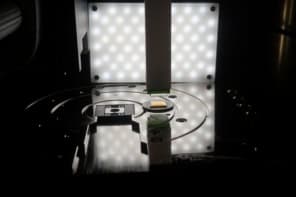
Electrical discharges could be controlled and guided along complex paths and even around obstacles, by using a variety of lasers, according to the latest work done by an international team of researchers. Forks of lightning, and on a much smaller scale, the tiny arcs of electricity used in everything from lighting to combustion engines, all follow highly unpredictable paths. The novel method has shown that lasers cannot only be used to guide discharges along straight lines, but also arcs and s-shapes. Greater control over discharge paths could open up a variety of potential applications, including in industrial-machining devices and lightning-protection systems.
While one might be more familiar with lightning, electrical discharges are used in many different technologies, in everything from gas-discharge lamps, arc welders, in spark machining and even to ignite fuel in combustion engines. Despite these many uses, however, our ability to control the exact path these currents take is limited – between the fixed points of the two electrodes the arcs are unpredictable, affected by various factors from air temperature to the presence of pre-ionized matter.
Wielding control
Past research, however, has demonstrated one method of controlling the discharges through the use of laser beams. These can ionize a channel through the air, locally lowering the gas density through heating and thereby creating a guide for the discharge along which there is reduced breakdown voltage.
“Controlling the gas breakdown and the associated electric discharge with laser beams is extremely appealing,” explains Matteo Clerici, a physicist at INRS and Heriot-Watt University. Recent developments in optical physics have brought to light new types of “non-diffracting” laser beams with interesting properties. Made using different lenses, these beams are not concentrated on a single point, as with a regularly focused laser.
Self-healing beams
Instead, the light may be concentrated along a line, as within a Bessel beam (created using an axicon, or conical, lens), or along a parabola, as within an Airy beam (created using a binary phase mask). Both Airy and Bessel beams have the unusual ability of being able to “self-heal” – if their intensity peaks are blocked, these lasers may be able to reconstruct themselves on the other side of the obstacle. This is thanks to how different points along these lasers are sustained by different portions of the input beam that creates them.
Clerici and his colleagues wondered if these unusual beam properties might be applied to better guide electrical discharges. To test their hypothesis, the researchers fired different laser beams between two wire electrodes, placed five centimetres apart, between which a high voltage (of 15 kV) was then applied. Photographs of the beams were taken, showing both the initial, ionization-induced fluorescence along the laser, as well as the path of the subsequent discharge.
In the case of a regular (Gaussian) laser beam, a distorted and largely unpredictable discharge was seen to form along the beam’s path. In contrast, a Bessel beam – whose high-intensity peak is much smaller in cross-section – resulted in a discharge guided along a significantly more defined straight line. In a similar fashion, a curved and well-defined discharge was seen to form along the path of a self-bending Airy laser beam – and combining two Airy beams enabled the researchers to guide the discharge along an s-shape.
Laser lasso
Furthermore, when an obstacle was placed in the direct line of both the Airy and Bessel beams, the self-healing properties were seen to allow the discharge to leap over the obstacle – leaving it undamaged – with the spark returning to the laser guide on the other side.
Practical considerations
“This work opens the way of directing electric discharges and possibly energy along arbitrary paths in free space,” comments Stelios Tzortzakis, an optical physicist at the University of Crete, who was not involved in this study. Jean-Claude Diels, a physicist at the University of New Mexico, who was also not involved, similarly commends the study for its interesting results. He cautions, however, that the use of laser beams may scale up poorly to applications requiring discharges over larger distances – as might be required for lightning triggering and protection systems. “The experiments are quite interesting for small-gap-discharge experiments, where the air is ionized, and the [laser beam] indeed produces a conductor for triggering and guiding the discharge,” says Diels. But he adds that we now know that long-gap discharge is triggered and guided by “air rarefaction by the shock wave created in air by recombining ions. Indeed, the discharge is seen to start a long time after the ions have recombined, and the channel created by the light filament is no longer conducting”, meaning that it will be quite a challenge to apply Clerici’s findings to guide lightning.
With their initial study complete, Clerici and colleagues are now exploring the potential to guide discharges along more elaborate trajectories, and around tighter arcs, by using more complicated optical elements. While the current work utilized only static optical elements, Clerici notes that the potential also exists to guide discharges using reconfigurable devices such as spatial light modulators or deformable mirrors. He adds that “this may become relevant for machining and welding applications, where complex operations may be performed without moving the samples.”
The research is described in Science Advances.


